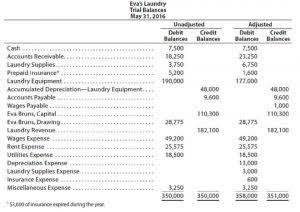
The net amount of accounts receivable outstanding does not change when this entry is completed. The method does not involve a reduction in the amount of recorded sales, only the increase of the bad debt expense. For example, a business records a sale on credit of $10,000, and records it with a debit to the accounts receivable account and a credit to the sales account. After two months, the customer is only able to pay $8,000 of the open balance, so the seller must write off $2,000.
- The allowance method follows GAAP matching principle since we estimate uncollectible accounts at the end of the year.
- The write off amount is debited as the expense in the period approved to write off in the income statement.
- It’s simple to use and recognizes unpaid debts only when they are deemed uncollectible.
- The adjusted balance in Allowance for Doubtful Accounts should be $31,800.
- If you use the direct write-off method to manage bad debt, you already have that number ready when you file your business’s taxes.
- We know some accounts will go bad, but we do not have a name or face to attach to them.
Accounting for the Direct Write-Off Method
The allowance method adheres to the GAAP and reports estimates of bad debt expenses within the same period as sales. The allowance method is a type of accounting that handles bad debts in a manner that follows the matching principle. This means it accounts for expenses during the period they were incurred–and not at a later time when an account receivable becomes uncollectible. The two accounting methods used to handle bad debt are the direct write-off method and the allowance method. When using the percentage of receivables method, it is usually helpful to use T-accounts to calculate the amount of bad debt that must be recorded in order to update the balance in Allowance for Doubtful Accounts.

Journal Entry for the Direct Write-off Method
Because customers do not always keep their promises to pay, companies must provide for these uncollectible accounts in their records. The direct write-off method recognizes bad accounts as an expense at the point when judged to be uncollectible and is the required method for federal income tax purposes. The allowance method provides in advance for uncollectible accounts think of as setting aside money in a reserve account. The allowance method represents the accrual basis of accounting and is the accepted method to record uncollectible accounts for financial accounting purposes. To record the bad debt, which is an adjusting entry, debit Bad Debt Expense and credit Allowance for Doubtful Accounts. When a customer is identified as uncollectible, we would credit Accounts Receivable.

What Is Wrong with the Direct Write off Method?

That allows us to record the bad debt but since accounts receivable is simply the total of many small balances, each belonging to a customer, we cannot credit Accounts Receivable when this entry is recorded. This estimate is based on the sales and collections information from previous years and is reported by setting up a holding account called the allowance for doubtful accounts x. This accounting principle allows for the client’s balance to remain while reducing the accounts receivable on the balance sheet by creating a contra-asset account.
It also deals in actual losses instead of initial estimates, which can be less confusing. The allowance method offers an alternative to the direct write off method the direct write-off method is used when of accounting for bad debts. With the allowance method, the business can estimate its bad debt at the end of the financial year.
- In other words, it can be said that whenever a receivable is considered to be unrecoverable, this method fully allows them to book those receivables as an expense without using an allowance account.
- This is called the matching principle, according to Accounting Tools.
- Rather than writing off bad debt as unpaid invoices come in, the amount is tallied up only at the end of the accounting year.
- Put simply, with this method, you debit the amount from the Bad Debts Expense account and credit Accounts Receivable.
- The aging method is a modified percentage of receivables method that looks at the age of the receivables.
📆 Date: May 3-4, 2025🕛 Time: 8:30-11:30 AM EST📍 Venue: OnlineInstructor: Dheeraj Vaidya, CFA, FRM
- Accounting for them in the books is an integral part of managing the risks of the business.
- Below, we’ll explain what this method is, how it works, and when to use it.
- As previously mentioned, chances are, you’ll be recording your bad debt expense in a different accounting period than when you recorded the revenue.
- The direct write-off method is used only when we decide a customer will not pay.
- The allowance method, while following the GAAP, is based on an estimate at the end of a financial year.
One issue that immediately crops up when it comes to this method is that of direct write off method GAAP compliance. The direct write off method doesn’t comply with the GAAP, or generally accepted accounting principles. unearned revenue The direct write-off method can be a useful option for small businesses infrequently dealing with bad debt or if the uncollectibles are for a small amount. How do you record the sale of inventory to a customer who the credit manager deems will have a 10% chance of paying? The sale occurred December 1st 2015 and has payment due in 60days, so at year end December 31st 2015 the account is not yet due.

Direct write off method definition
The direct write off method is a way businesses account for debt can’t be collected from clients, where the Bad Debts Expense account is debited and Accounts Receivable is credited. If you’re a small business owner who doesn’t regularly deal with bad debt, the direct write-off method might be simpler. But the allowance method is more commonly preferred and often used by larger companies and businesses frequently handling receivables. If you’re wondering which method is best for your small law firm chart of accounts business, speak with a professional for insights into your specific situation. The most important thing to remember when working with the allowance methods for bad debt is to know what you have calculated!
